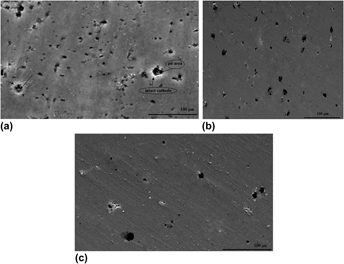Article contents
Evaluation of the effect of ageing heat treatment on corrosion resistance of Al–Ag alloy using electrochemical methods
Published online by Cambridge University Press: 17 June 2016
Abstract

The corrosion resistance behavior of age-treated at 250 °C, 150 °C and solution-treated at 540 °C Al–4.2 wt%Ag alloys were investigated in a 3.5 wt% NaCl solution using cyclic potentiodynamic polarization (CPP) and electrochemical impedance spectroscopy measurements. Furthermore, the Vickers microhardness, microstructure, and phase analysis were studied by Vickers microhardness test, scanning electron microscopy (SEM), and x-ray diffraction. The Vickers microhardness test indicated significant increase in the hardness of the aged samples due to precipitation formation in the Al matrix. SEM images of all samples after corrosion tests showed pitting corrosion. Furthermore, it is found that the presence of ageing precipitates (Ag2Al plates) in the age-treated samples created local galvanic cells and can led to the formation of the anodic and cathodic sites. Hence, the corrosion resistance decreased compared to the solution-treated sample without any precipitates. In addition, for more ageing temperature at 250 °C in comparison with 150 °C, was made more anodic and cathodic sites due to more Ag2Al precipitates formation, and decreased resistance to pitting corrosion. Besides, the aluminum and silver oxides were corrosion products. The major phase was aluminum oxide because the Al was the main element of the alloy.
- Type
- Articles
- Information
- Copyright
- Copyright © Materials Research Society 2016
References
REFERENCES
- 5
- Cited by




